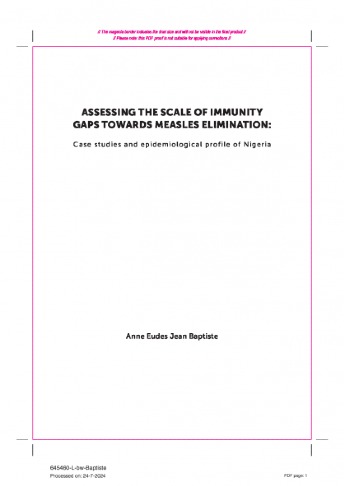PhD defence A.E. (Anne Eudes) Jean Baptiste
| When: | Tu 15-10-2024 11:00 - 12:00 |
| Where: | Academy Building |

Assessing the scale of immunity gaps towards measles elimination
Case studies and epidemiological profile of Nigeria
In 2021, there were approximately 128,000 measles-related deaths, primarily among unvaccinated or incompletely vaccinated children under 5 years old. Rubella, while milder in children, can have devastating effects if contracted by pregnant women, leading to congenital rubella syndrome (CRS) in their offspring, causing various severe disabilities and complications. The international effort to eliminate measles and rubella began with the Global Measles and Rubella Strategic Plan 2012–2020 (MRSP 2012–2020) by the World Health Organization (WHO) and the Measles and Rubella Initiative (M&RI), aiming to eliminate these diseases in at least five WHO regions by the end of 2020. Remarkable progress has been made with the implementation of this plan. However, many countries fell short of the 2020 elimination goal. The Measles and Rubella Strategic Framework 2021–2030 (MRSF 2021–2030) emphasizes the need for localized and integrated approaches, transitioning from standardized strategies to address measles and rubella immunity gaps effectively.
The thesis seeks to gain insight into Nigeria's measles epidemiology and immunity gaps while assessing past and current control initiatives to enable targeted interventions for enhancing population immunity and ultimately eliminating these diseases. In Chapter 2 of the thesis, we provided a comprehensive analysis of measles vaccination coverage and incidence rates from 2008 to 2018 in Nigeria. It highlighted low measles vaccination coverage, particularly in the North, with only 54% coverage in 2018. Most confirmed measles cases (85.5%) were reported from the North, and 70.8% of these cases were among unvaccinated children. The annual incidence rate varied over the study period, with the highest rate in 2013 and the lowest in 2009. Incidence was highest among children aged 9-11 months and 12-59 months, with higher rates in the North than in the South. In Chapter 3, we evaluated the use of a readiness assessment dashboard during the 2017/2018 measles vaccination campaign in Nigeria. It showed that states with high readiness a week before the campaign had better post-campaign coverage survey scores, emphasizing the dashboard's importance. However, some states with good readiness scores still had poor post-campaign coverage, indicating other influencing factors. Chapter 4 discussed geocoded estimates of zero-dose and under-vaccinated children, emphasizing that most zero-dose children are in northern Nigeria. The study aligned with the Immunization Agenda 2030 (IA2030), aiming to reduce zero-dose children by 50% and expand immunization services to marginalized/underserved communities. Chapter 5 examined challenges in implementing a measles campaign in Borno State due to conflict. Security challenges affected campaign performance, emphasizing the need for adaptive strategies. In Chapter 6, we discussed a measles outbreak in Borno State in 2019 and the challenges of conducting outbreak response immunization (ORI) in conflict-affected areas. Despite challenges, the MCV demonstrated high vaccine effectiveness. Finally, in Chapter 7, we measured and compared the input costs of standalone measles vaccination campaigns with integrated strategies. Integration resulted in significant cost savings.
|
Promotors:
|
prof. dr. E. (Eelko) Hak, prof. dr. E.A. Sanders
|
|
Copromotor:
|
dr. S.J.M. Hahne
|
